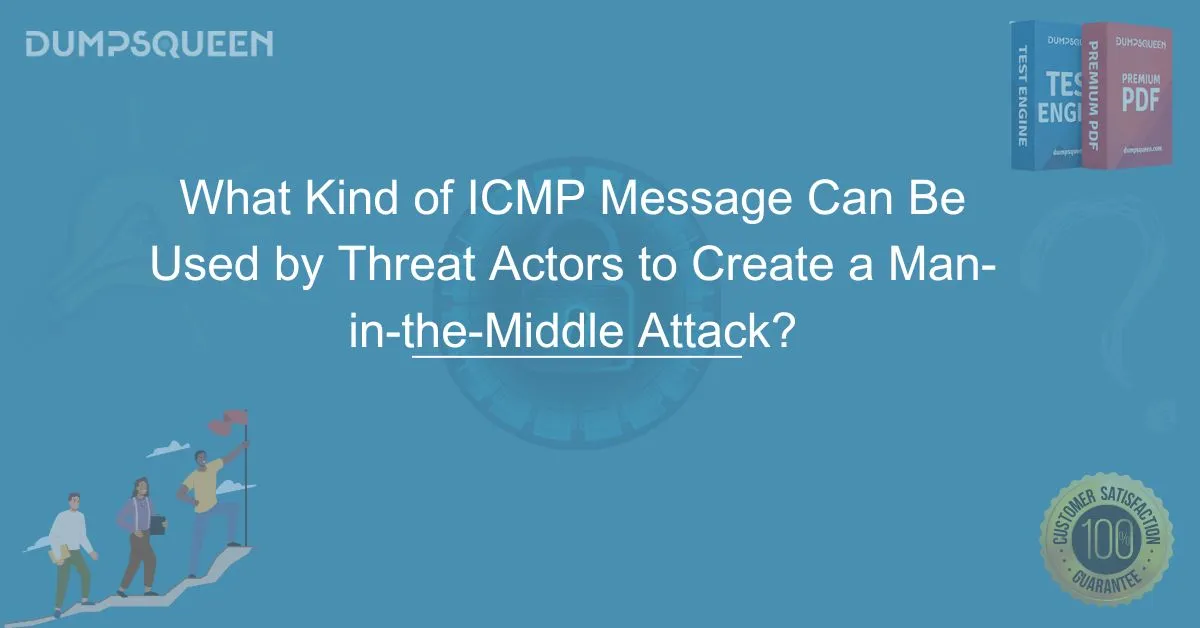Introduction
The Internet Control Message Protocol (ICMP) plays a crucial role in network communication, helping devices report errors and operational information. However, cybercriminals can manipulate ICMP messages to conduct various attacks, including Man-in-the-Middle (MITM) attacks. In this blog, we will explore how threat actors exploit ICMP messages to perform MITM attacks, discuss their implications, and outline measures to mitigate such threats.
Understanding ICMP and Its Functionality
ICMP is a network layer protocol used primarily for diagnostic and error-reporting purposes. Common ICMP messages include Echo Requests (ping), Destination Unreachable, Redirect Messages, and Time Exceeded. These messages allow network devices to communicate issues and optimize routing paths. However, malicious actors can exploit ICMP to intercept and manipulate data transmissions.
How ICMP Can Be Exploited in a MITM Attack
A Man-in-the-Middle (MITM) attack occurs when an attacker secretly intercepts and possibly alters the communication between two parties without their knowledge. ICMP messages can facilitate such attacks in the following ways:
1. ICMP Redirect Attack
ICMP Redirect messages inform a host of a better route to reach a destination. Threat actors can exploit this feature by sending false ICMP Redirect messages, tricking devices into routing traffic through a malicious node. Once the attacker gains control over the traffic, they can eavesdrop on sensitive data, inject malicious content, or modify packets.
2. ICMP Spoofing
Attackers can spoof ICMP messages to appear as if they are coming from legitimate sources. This technique can be used to redirect traffic, facilitate session hijacking, or launch denial-of-service (DoS) attacks.
3. ICMP Router Advertisement Attack
ICMP Router Advertisement messages are used in IPv6 networks to announce available routers. A malicious actor can send fake Router Advertisement messages to reroute traffic through their controlled network, leading to data interception and manipulation.
4. ICMP-Based Covert Channels
Threat actors can use ICMP messages to establish covert communication channels between compromised devices. These channels can facilitate data exfiltration, command and control (C2) operations, or malware propagation without detection.
Real-World Examples of ICMP MITM Attacks
Several high-profile cyber incidents have leveraged ICMP vulnerabilities:
-
Sniffing Encrypted Data: Attackers have used ICMP Redirect messages to reroute encrypted traffic to malicious proxies.
-
Session Hijacking: By manipulating ICMP packets, hackers have intercepted and taken control of active network sessions.
-
Malware Communication: Some malware strains use ICMP messages to communicate with command-and-control servers discreetly.
Mitigation Strategies Against ICMP MITM Attacks
Organizations and individuals can take the following steps to mitigate the risk of ICMP-based MITM attacks:
1. Filter and Restrict ICMP Traffic
Network administrators should configure firewalls to block or restrict unnecessary ICMP traffic, especially ICMP Redirect and Router Advertisement messages.
2. Use Secure Protocols
Encrypting communications using protocols like TLS, SSH, or IPsec ensures that even if traffic is intercepted, the data remains secure.
3. Implement Network Segmentation
Dividing networks into isolated segments reduces the attack surface and limits the impact of an ICMP MITM attack.
4. Monitor Network Traffic
Regularly inspecting ICMP traffic for unusual patterns can help identify and mitigate potential attacks before they escalate.
5. Disable ICMP Redirect Messages
Disabling ICMP Redirects on routers and end devices prevents attackers from manipulating routing information.
Conclusion
ICMP is an essential protocol for network diagnostics, but it can also be exploited by threat actors to conduct Man-in-the-Middle attacks. By understanding how ICMP messages can be abused and implementing robust security measures, organizations can reduce the risk of such attacks. Regular network monitoring, restricting unnecessary ICMP traffic, and using encryption are key strategies to safeguard network integrity. Staying proactive in cybersecurity practices ensures that networks remain resilient against evolving threats.
For more expert insights on cybersecurity and IT certifications, visit DumpsQueen – your trusted partner for exam preparation and professional growth.
Free Sample Questions
1. Which ICMP message type is commonly exploited in MITM attacks?
A) ICMP Echo Request
B) ICMP Redirect
C) ICMP Destination Unreachable
D) ICMP Time Exceeded
Answer: B) ICMP Redirect
2. How can attackers use ICMP messages to redirect traffic through a malicious node?
A) By sending ICMP Echo Requests
B) By using ICMP Redirect messages
C) By blocking ICMP packets
D) By encrypting ICMP packets
Answer: B) By using ICMP Redirect messages
3. What is one of the best ways to mitigate ICMP-based MITM attacks?
A) Allow unrestricted ICMP traffic
B) Disable ICMP on all devices
C) Use encryption protocols like TLS or IPsec
D) Ignore all network security alerts
Answer: C) Use encryption protocols like TLS or IPsec



